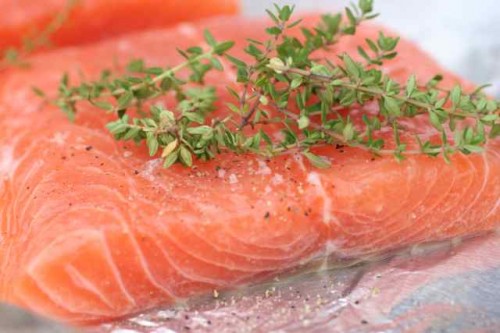It’s officially spring but winter and seasonal depression lag. In winter, and I’m speaking from having lived in Wisconsin, Chicago and New York, I craved maybe the worst foods to lift me from the winter doldrums. Comfort foods like potatoes, breads, pastas, and cookies – warm chocolate chip cookies – were on my mind and continue even here insunny rainy California. Instead of carbs, we need more Big D foods, those rich in vitamin D, to do the job.
Over the past few years, our commitment to staying out of the sun has been good for our skin, but bad for our vit-D absorption. In the winter when the sun is out for maybe twenty three minutes each day and those minutes we’re spending in windowless meeting rooms or holed up with a laptop, we can suffer from seasonal depression. What do we do about it? We eat away our sadness in the form of lasagna and scones. Okay those foods can make me happy for at least seven minutes until gloom returns.
 It stands to reason that if we fed our bodies more vitamin D, we might ward off seasonal depression, and thus, our craving for give-me-hugs food. Sure, we’ve been told that eating more in the winter (aside from the holiday engorgement) is our natural way of bulking up, like hibernating bears creating a winter layer. But, can’t we all agree that we’ve evolved enough past prairie life? Our bodies know we can put on a sweater and, unlike Laura Ingalls Wilder, we can close the window (is that why Pa cried?), rather than build up a Michelin ring of fat. An elder nutrition lady told me that our bodies needing more food in winter is a load of BS – “you’re just bored and you eat more,” she scolded me and my thighs.
It stands to reason that if we fed our bodies more vitamin D, we might ward off seasonal depression, and thus, our craving for give-me-hugs food. Sure, we’ve been told that eating more in the winter (aside from the holiday engorgement) is our natural way of bulking up, like hibernating bears creating a winter layer. But, can’t we all agree that we’ve evolved enough past prairie life? Our bodies know we can put on a sweater and, unlike Laura Ingalls Wilder, we can close the window (is that why Pa cried?), rather than build up a Michelin ring of fat. An elder nutrition lady told me that our bodies needing more food in winter is a load of BS – “you’re just bored and you eat more,” she scolded me and my thighs.
Recently, Cooking Light reminded me of the importance of vitamin D and thought it’s a good time to review the easiest ways to get more of it in our diets. First, let me say, not that many foods are naturally rich in vitamin D, so especially target fatty fishes: mackerel, salmon, and tuna.
- Salmon – splurge on the wild caught rather than farm raised – it’s less fatty, gives you 3x more vitamin D, and tastes better. Here are a few ideas to get you started:salmon in seattle andtasty fishcakes.
- Canned tuna – we’ve provided our own take on the Whole Foods cranberry tuna salad below.
- Eggs – each egg yolk offers about 5 percent of our daily requirement for v-D. Make these breakfast treats with whole eggs.
- Milk – is fortified with vitamin D, even nonfat milk, each 8 oz glass offering about 20% of the daily requirement. Lattes count.
- Sardines – if you’re brave.
Eat vitamin D rich foods, get a little sunshine, and add supplements where you need them. Have a D-lightful season.
seasonal D-pression, look to real comfort foods
1 large can tuna, spring water, low sodium
1/4 c fat free mayo
1/4 c chopped celery
1/4 c chopped red onion
1/4 c chopped dried cranberries
1 t fresh lemon juice
salt & pepper to taste
Mix and match according to your taste, but the cranberries are a must for this secret palate balancer – salty, sweet

1 Comment
The tuna salad looks delicious and not sure why we have avoided it this winter. I am declining those creamy, rich, hearty winter soups (did I say hearty? I meant fattening) and making a delectable tuna salad sandwich tomorrow! D-licious.
Leave a Reply